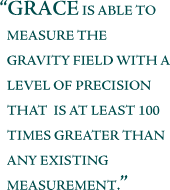

Gravity Anomaly Maps and The Geoid The Earth’s gravity field is depicted in two principal ways: gravity anomaly maps and maps of the Earth’s geoid. Gravity anomaly maps (see globe below) show how much the Earth’s
actual gravity field differs from the gravity field of a uniform, featureless
Earth surface. The anomalies highlight variations in the strength of
the gravitational force over the surface of the Earth. Gravity anomalies
are often due to unusual concentrations of mass in a region. For example,
the presence of mountain ranges will usually cause the gravitational
force to be more than it would be on a featureless planet — positive
gravity anomaly. Conversely, the presence of ocean trenches or even the
depression of the landmass that was caused by the presence of glaciers
millennia ago can cause negative gravity anomalies. |

GRACE |
||
|
The geoid is a hypothetical Earth surface that represents the mean sea level in the absence of winds, currents, and most tides. The geoid is a useful reference surface. It defines the horizontal everywhere and gravity acts perpendicular to it. A carpenter’s level aligns itself along the geoid and a carpenter’s plumb bob points down the vertical or perpendicular to the geoid. Water will not flow in aqueducts if the pipes are perfectly aligned along the geoid. Surveyors use knowledge of the geoid and the horizontal when they lay out highways and boundaries. Producing a precise model of the geoid has proven to be a challenge. Until recently, there was no single source for producing a geoid map. Data from several dozen satellites, along with surface measurements over land and from ships at sea, had to be combined to produce a model of the gravitational field. Traditionally, the models have done a fairly good job reproducing large-scale features of the gravity field, but have fallen short when it comes to reproducing finer-scale features or accurately describing time-variable gravity effects like those associated with the hydrologic cycle. GRACE provides, for the first time, global coverage of the Earth’s
gravity field every 30
days from a single source. GRACE is already able to measure the gravity
field with a level of precision that is at least 100 times greater than
any existing measurement, and continued improvements are expected as
the mission progresses. The finer details of the geoid that have evaded
scientists for so long are on the verge of being revealed. GRACE also
gives us our best opportunity to date to study time-variable gravity
effects. As the mission progresses and more data are added to the model,
the resolution of the geoid will improve even further. |
These “gravity anomaly” maps show where models of the Earth’s gravity field based on GRACE data differ from a simplified mathematical model that assumes the Earth is perfectly smooth and featureless. Areas colored yellow, orange, or red are areas where the actual gravity field is larger than the featureless-Earth model predicts—such as the Himalayan Mountains in Central Asia (top left of the left-hand globe)—while the progressively darker shades of blue indicate places where the gravity field is less—such as the area around Hudson Bay in Canada (top center of right-hand globe). |
||
|
As the geoid map becomes more detailed, the accuracy of satellite altimetry, synthetic aperture radar interferometry, and digital terrain models covering large land and ice areas — all used in remote sensing applications and cartography — will improve. These techniques provide critical input to many scientific models used in oceanography, hydrology, geology, and related disciplines, and will be used for a variety of applications including:
This enhanced knowledge should lead to a better understanding of the forces that drive El Niño and La Niña, more accurate seasonal forecasts of Earth’s weather patterns, an ability to track the changing distribution of water resources in critically important land aquifers, and improved forecasting of natural hazards. next: The Workings
of GRACE |
The Earth’s gravity signal changes day-to-day, even minute by minute. The image above shows how the average variability in Earth’s gravity field in August 2002 compared to the yearly average of 2001. The red and pink areas show where the variation measured in August 2002 is the most different from the variation measured for the year 2001, while the blue and purple areas show where the variation measured in August 2002 is just about the same as the variation measured for the year 2001. The variability has to be accounted for using models in order to produce a mean gravity field that is useful for hydrologic applications. (Image credit: Paul Thompson / UT-CSR) |